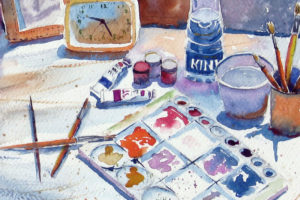Emphasis on Watercolour painting:
Watercolour painting is a unique art which requires finesse as the pains are transparent. The watercolour shows through the painting similar that of every stroke. Conventionally, artists work from light to dark shades. Currently, they are booming in blend of digital and mixed media projects and calligraphy. These colours actually come in forms such as tubes, cakes, concentrated liquid form and semi moist paints but tube paints are considered to be the best. It all depends on the combination you choose for where the painting is made and the eventual outcome.
Essentials and Skills:
One who wants to learn watercolour shall opt for watercolor techniques class to get through the basics and set foot. Being transparent, there is a minimal chance of erasing mistakes only through coaching. Currently the watercolour set surface include illustration board, clay board, watercolour paper, canvas or boards. So these paintings can be mounted over boards, wooden blocks, and canvas and then can be framed or gallery wrapped. The finished painting can be framed via mats or glass or sprayed coatings for protection.
- Watercolour Class: Books and online classes are important aids in learning this art in detail about its supplies and gaining the knowledge.
- Watercolour Paper: Good quality papers shall be considered for best results as they heavier ones between 140-400 pounds are best. Also as these come in different textures like hot, cold and rough pressed; hot pressed is the smoothest among others.
- Paints: Good quality pains are necessary in pans or trays and watercolour may also be added. They are brighter, concentrated and lot easier to blend and doesn’t fade much.
- Paint Brushes: High quality paint brushes coming in natural and synthetic fibres. Also they are found in different shapes such as angled, round, filbert or flat aiding in holding the liquid with its soft bristles.
For the final Sketch:
Once set, go for the painting by carefully planning the colours required to be filled and things such as pigmentation, shading and spread via a course would come in handy. Fixing a mistake is possible by dampening the area with brush and clean water, lift the paint off with a sponge or cloth. Although, it may not remove paint completely in some cases but is effective.
Shading is again an important watercolour technique and create shadow, depth and distance affect. The classes with also go through wet on wet and wet on dry training and blending of the two techniques with digital media. Once these basics are grasped by the learner, it becomes fairly easy for them to develop their own signature style with aesthetic value. In fact some techniques demonstrate the combination of pen and ink with watercolours to create wonderful mixed media samples of art.




